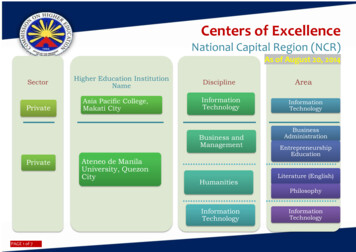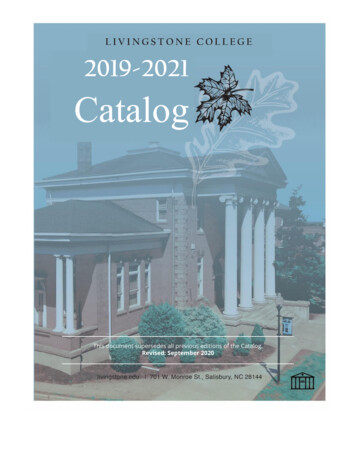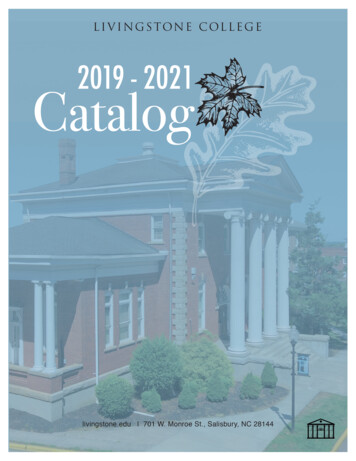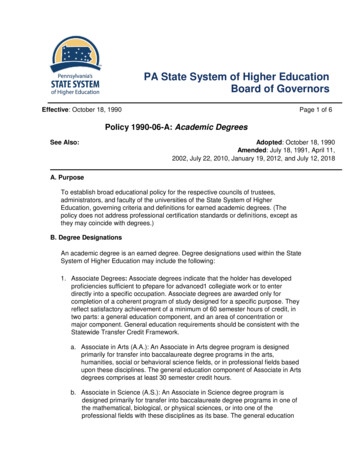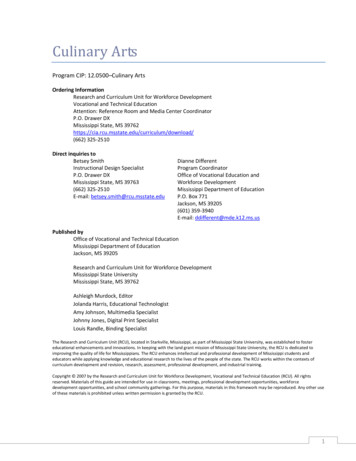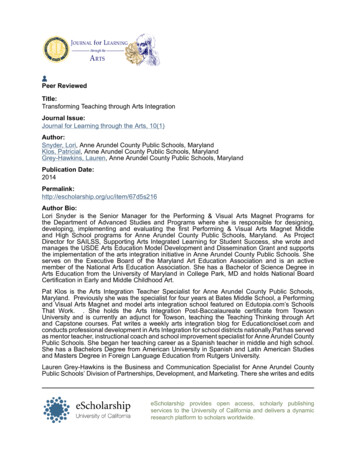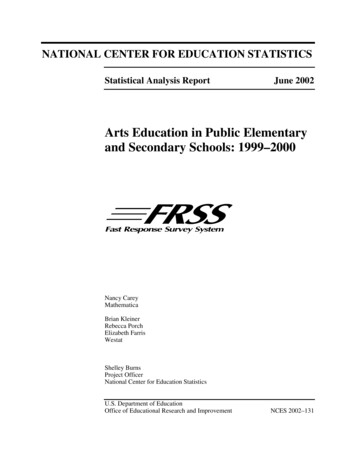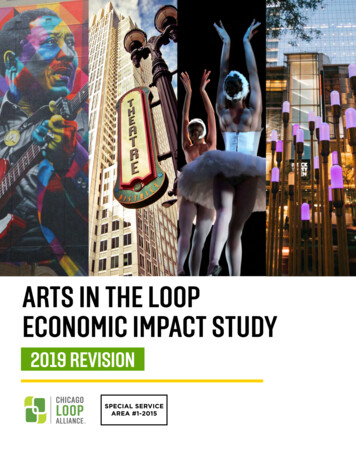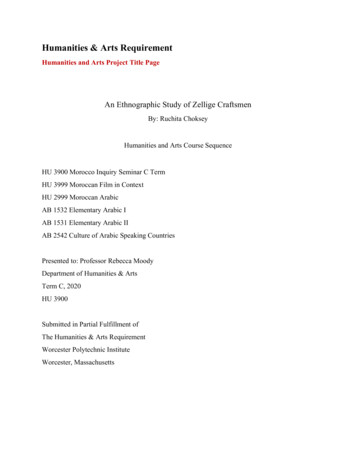
Transcription
Humanities & Arts RequirementHumanities and Arts Project Title PageAn Ethnographic Study of Zellige CraftsmenBy: Ruchita ChokseyHumanities and Arts Course SequenceHU 3900 Morocco Inquiry Seminar C TermHU 3999 Moroccan Film in ContextHU 2999 Moroccan ArabicAB 1532 Elementary Arabic IAB 1531 Elementary Arabic IIAB 2542 Culture of Arabic Speaking CountriesPresented to: Professor Rebecca MoodyDepartment of Humanities & ArtsTerm C, 2020HU 3900Submitted in Partial Fulfillment ofThe Humanities & Arts RequirementWorcester Polytechnic InstituteWorcester, Massachusetts
Abstract: Zellige is a well-known traditional Moroccan craft, however, there is a gaping lack ofdocumentation about the people who actually make it. Through this paper, I aim to address thisissue through ethnographic fieldwork focused in Fes and Rabat, Morocco, through which I bringto life the stories of the workers and connecting the pieces of their knowledge and experience.
AcknowledgementsThere were so many people who contributed to the creation and accumulation of this knowledge.I would like to thank Professor Rebecca Moody for being my advisor and guide, Yassine,Fatima, and Adil for coming on multiple trips to workshops as my translators, and Abdulilah,Azdil, Mouhssin, Hasan, Abdul, Driss, Houssam, Yassine, Omar, Abdula, and Mohammed fortheir information, stories, and tea. Good luck for the future and inshallah may our paths crossagain.
The Many Pieces of Zellige: An Ethnographic Study into the lives ofmodern-day Moroccan zellige craftsmenBy Ruchita Choksey(Left) Zellige found in the wall of a home, (Right) Zellige seen at the Hassan II MosqueMorocco has captivated travelers for years, drawing in intrigued stares from all over theworld with zellige, the beautiful mosaic artwork that has a distinct Moroccan spell. Zellige is acentral pillar in Moroccan crafts, with its history beginning even before the foundation of thecountry. This art form takes years to master and has many different aspects that combine tocreate beautiful brilliant patterns. The torch bearers of the craft faced a renaissance under HassanII1 in the 1980s, but are now reportedly facing a decline in need and demand. Moroccancraftsmen of zellige have learned how to adapt with the times from the effects of bothglobalization and the ever-shifting art industry. Through my research and fieldwork, I aim toThe previous King of Morocco. So far in Morocco’s independence there have been three kings:Mohammed V from 1957-1961, Hassan II from 1961-1999, and the current King Mohammed VIfrom 1999.1
document and learn about the current realities of being a zellige craftsman2 in modern dayMorocco. There have been many changes to zellige in the past years, from the economy toglobalization to the monarchy. However, even with how prevalent zellige is in Moroccan societyvery little is written about the workers.3 Within these seven weeks I aim to begin to weave artand anthropology to learn about the lives of these workers that can be found in every city inMorocco.While I will in no way be able to learn everything there is to zellige and the lifestyleassociated with making it, I hope to begin the process of filling the gaps and bringing thecomplicated mosaic of globalization, change, economy, family and zellige to life for futurerecords. Throughout this paper I will compare what is previously documented regarding theindustry and what workers from Rabat and Fes have personally believed to be their experiencesfrom working in the field4. First I will briefly discuss the demographic and general backgroundof the people interviewed, and then dive into their family relations, the effects of the monarchy,and the changes that have both happened to zellige and what the artists would like to see in thefuture for the industry. These craftsmen have dedicated their being to zellige, so through thispaper I hope to bring recognition to the many different aspects that go into their lives.When I tell people about my research they get confused. To give some perspective, at thetime of this paper I am an undergraduate mechanical engineering student studying at a tech2Through my fieldwork I have only encountered men doing traditional zellige, which is thefocus of this paper. I have seen women paint zellige which I will briefly talk about, but the mainartists discussed in this paper are all men hence the gender exclusive term.3While there is some work that can be found on the numerology and process of zellige, there isnext to nothing available about the workers themselves.4All the interviews I arranged required the help of a translator, and is why there are little to nodirect quotes in this paper but rather paraphrasing and summaries.
school in the United States. And I am doing a humanities-based research project in Morocco.These two do not generally add up. But for me they make sense. My family always loved the artsand I am no exception; I have been dancing since I was 3 and learned a couple of musicalinstruments. I always loved working with my hands and tried (and enjoyed but did not succeed)in ceramics, painting, and pastels. We loved the arts and I always appreciated anyone who hadthe ability to create beautiful things. Personally, I never felt creative enough for the arts, and Iwas much to practical of a middle-schooler, so I switched my focus to another type of hands-oncreation: engineering. I love engineering so much and have enjoyed my time so far, but whenoffered the chance to research in Morocco I accepted in a heartbeat. Little did I know just howmuch I would come to love this country and the ethnographic work of zellige workers.Throughout my time researching I was able to learn about their lives, make jokes, and bypass thelanguage barrier through pure genuine interest and kindness from both sides. I have gotten toknow these workers so through this paper I will try to bring to life the quiet, sweet, charismatic,humble, talented and dedicated friends I have come to make along my journey.Morocco has always caught the wandering eyes from all over the world with zellige as amotivating factor of awe even in the 20th century. In the article “Manufacturing Exotica: EdithWharton and Tourism in French Morocco, 1917-20” Robert Hunter includes a quote fromWharton saying that while the patterns may be repetitive “the effect upon the eye is notmonotonous, for a patient artist has infinitely varied the combinations of pattern andjuxtaposition of color.”5 Hunter goes on to explain how Edith Wharton’s articles and book5F. Robert Hunter, “Manufacturing Exotica: Edith Wharton and Tourism in French Morocco,1917-20” Middle Eastern Studies 46, no. 1 (2010), accessed November 13, 0263200903432266
strongly influenced a lot of the tourism travel to Morocco and how she would write pages uponpages about its architecture and designs found. Edith Wharton is actually considered the personwho fueled the interest and image of Morocco as her stories and articles romanticized thecountry as a natural place frozen in time. According to Hunter “Few previous travel writers,however, possessed the imagination, acute powers of observation, and masterful writing skills ofEdith Wharton.”6 Wharton’s words came at a prime opportunity as the country was expanding itstourism industry, making the already beautiful descriptions immortalized as the image ofMorocco.In another article, “The Changing Face of Morocco under King Hassan II”, JenniferRoberson talks about how Hassan II decided to use the arts to make Morocco unified and under asingle image. He believed that by channeling a nationalist spirit through traditional handicrafts,Morocco would be able to knit together under a single modern identity. At the time Hassan IIstarted his movement, which lasted from the 1960s till his death in 1999, many other countriesand architects were trying to mimic a modern western approach. This made his monuments standout even more as beautiful refreshing images of Moroccan glory. Looking back at Hassan II’smovement, Roberson notes that his first major project, the Mausoleum of Mohammed V, “ was officially hailed as one that brought about a renaissance in Moroccan art and expressed thenational aspirations of the Moroccan people, as well as their leader (Mohammad V) and theirnative craftsmen.”7 Under his initiative, the zellige world flourished with grand commissions and6F. Robert Hunter, “Manufacturing Exotica: Edith Wharton and Tourism in French Morocco,1917-20”Middle Eastern Studies 46, no. 1 (2010), accessed November 13, 02632009034322667Jennifer Roberson, "The Changing Face of Morocco under King Hassan II." MediterraneanStudies 22, no. 1 (2014), accessed November 13, 2019,https://www.muse.jhu.edu/article/547158.
interests peaked. In contrast, today these craftsmen are left trying to make their way in a worldthat no longer treats their craft as gold and have had to adapt and learn to navigate these newwaters.Zellige of the (Left) Hand of Fatima and (Right) Pillars at Hassan II Mosque.The history of zellige is one that is difficult to trace. The art style is native to NorthAfrica and is generally agreed to have Moroccan origins as the oldest forms of the art have beendocumented there. Fragments of old zellige depictions have been found dating all the way backto the twelfth century Almohad dynasty.8 The repeating patterns found in zellige are a stylecalled arabesque, which is a way to show zellige’s Islamic nature. The repetition symbolizes8Ann Shafer, “No man is an island: globalisation and resilience in the Fez zillīj tradition,” TheJournal of North African Studies 24, no. 5 (2018) 758-785, accessed November 13, i.edu/doi/full/10.1080/13629387.2018.1483877
different traits, such as peace and tranquility, depending on the pattern. The overall intricatedesigns themselves are passed down through the workshops. At the same time, these patternsalso evolve. In “No Man is an Island: Globalisation and Resilience in the Fez zillīj tradition”Ann Shafer notes that patterns are in an ever-shifting state, stating “[ ] young craftsmen aredesigning new patterns at a greater rate than before and that some highly complex patterns arebeing forgotten, but the core patterns are still memorised and have remained the staple of thetrade, it seems, since its inception.”9There are two main parts to creating a zellige masterpiece. The first process is preparingthe tiles. All clay used for the tiles is from Morocco, making zellige 100% Moroccan-made.Workshops will either tend to have agreements with companies that sell the clay or will get acertain amount guaranteed from the government. Next, someone has to lay the clay out andprepare it so that it can be hardened into tiles. They will then cut the tiles to match what isneeded for the current zellige that is being worked on. The process of cutting tiles is one thatmany people dedicate years towards through apprenticeships. Someone uses a model of the pieceto sketch out multiples on the clay tile, and then the tile is carefully broken down a line to isolateeach piece. In order to carve, the tile is leaned against a ledge that comes out of the stand theyuse and a pickax is used to carefully cut against the piece of tile that is touching the ledge,leading the piece to break on the line. The second part is assembling the design. The tiles must beplaced next to each other in the correct placement face-down. Then, an adhesive, like concrete, is9Ann Shafer, “No man is an island: globalisation and resilience in the Fez zillīj tradition,” TheJournal of North African Studies 24, no. 5 (2018) 758-785, accessed November 13, i.edu/doi/full/10.1080/13629387.2018.1483877
applied once the whole image is finished, binding all the tiles together.10 This part of the processis difficult because you cannot see what image you are creating; it is as if you are puttingtogether an all-white puzzle.(Above) Once the tiles are laid down, they are put in a frame and then cemented over.The craftsmen of zellige get into the trade through apprenticeships that tend to last aroundten years and start on average around the mid-teen years. Contrary to popular belief, most peoplewho choose to apprentice are not doing it to keep up a family business but rather that it was thefuture they desired. In the past the zellige industry was considered a stable one11, so dedicatingone’s life to a part of the zellige making process was an acceptable decision.Previously the monarchy has tried to change the artisan sector, which has stronglyimpacted the zellige craft in different ways. The monarchy is trying to increase participation inAnn Shafer, “No man is an island: globalisation and resilience in the Fez zillīj tradition,” TheJournal of North African Studies 24, no. 5 (2018) 758-785, accessed November 13, i.edu/doi/full/10.1080/13629387.2018.148387711It was a stable industry because of all the structures Hassan II issued, so there was always workin zellige.10
handicrafts by offering free craft education12. Through this education, the government hopes tokeep traditional crafts alive while also keeping a part of the workforce in Morocco. There is alsoan aim to create an official label for authentic zellige places called the National MoroccanHandicraft Label. However, documentation on the true number of zellige workshops that havegone through the paperwork to get the label is hard to find. In regard to the process of makingzellige, the current king Mohammed VI has pushed for more environmentally-friendly kilns,which has received a lot of backlash from zellige factories and workshops. According to the IQPreport “Preservation and Progress: The Socio-Economic and Environmental Effects ofModernizing Zillij Production” from 2012 the craft has been perfected over many years so thatthe tiles are strong and bright. The new kilns that are being pushed by the governmentsupposedly create lower quality tiles where the tiles “ are brittle, the colors are dull, and theglazes become rippled.”13 Because of the low quality tiles produced from these governmentsupported kilns there is much backlash from the zellige industry.Through my research, I aim to document and learn about the current realities of being azellige craftsmen in modern day Morocco. There have been many changes to zellige in the pastyears, from the economy to globalization to the monarchy. However, even with how prevalentzellige is in Moroccan society, very little is written about the workers. Hopefully in these sevenweeks I am able to get different perspectives and see the many pieces that make up zellige.12Hamlin, Cassandra Lynne, Helei Duan, John Joseph Amante, and Mikhail YuryevichMorozov. “Recommendations Toward Expanding the Scope of the Zellij Craft Industry,” n.d.13George Tucker Gette, Micah L. Flock, Stephen Philip Oliveira. “Preservation and Progress:The Socio-Economic and Environmental Effects of Modernizing Zillij Production”
My fieldwork was primarily located in Fes, at the Art D’Argile workshop and Poterie deFes workshop. In addition, I also interviewed a few people in assorted local workshops in theRabat medina. The demographic of the 10 main craftsmen14 ranged from 26 years old to 56 andwere all men15. From multiple interviews and observations, I learned that there werecontradictions from what was written in literature to reality, such as the worker’s perspectives ofthe current state of the field and of the succession of zellige, which will be discussed throughoutthe paper. There is so much to the lives of the workers, but this paper is focusing on the generalbackground of the interviewed workers, and then dive into how they started their path of zelligeand their families. Branching outward I will talk about how they viewed the effects of thechanging monarchy and the current atmosphere towards zellige, ending with the changes theywant to see in the future to the field of zellige. I want to bring lives of the zellige workers out ofthe dark workshops and into the light.The main Moroccan zellige industry hub is located in Fes, the old city already known forits history and crafts. All of the craftsmen I talked to, even those who were not working in Fes,were from Fes, either from being born in or by coming to the city with their family from a youngage. They ranged in age from 26 to 56, with there being a concentration around the late 20s and30s and only a couple workers in their 50s16. All the workers from the Fes workshops lived in themedina, but the exact location varied. Some lived in the old medina while others lived further on14Because all of the data gathered were from men and I had only seen men doing the traditionalzellige jobs, I will often be using gender-exclusive language such as “craftsmen”15The only seen instance of women working in the zellige shop is if they painted the designsonto pottery tiles, which is not exactly zellige but rather normal ceramic work.16I would like to stress that this is not a general assessment of all zellige workers; it is just thedemographic of the people I was able to interview.
the outskirts near where the zellige workshops were17. The majority of the workers started zelligeat a young age, with the earliest starting at 7 years old and the latest at 18. Some of the workerswho started at a young age first apprenticed and learned from those around them, later movingon to becoming qualified workers.As a result of the early start to their careers, the majority of the workers had only finishedsome school before going into their career, and very few of them had done any jobs prior18. Halfof the people interviewed had stayed in the same workshop their whole life, while the rest movedaround different workshops around Fes. From the interviews, I noticed that if the workers hadapprenticed in a workshop before starting to work, they were more likely to have remained inthat workshop for the majority or all or their career.There was a general agreement among the workers that if you didn’t start the craft at ayoung age, there was no way one could eventually master it. The interviewed craftsmen had jobsat different stages of the zellige making process, from drawing the tiles, to cutting them and thento laying the tiles. They all started out by drawing the tiles and then moved to cutting them. Fromhere, some people chose to specialize in cutting tiles and would remain in their job, while otherseventually progressed to laying the tiles. Everyone worked 8 hours a day for 6 days a week19.Those whose job was cutting the pieces got paid per piece and the amount varied based on thesize and complexity of the piece, whereas if you were to be laying tiles you got paid the same flatrate every week. According to the craftsman in Rabat, when he was apprenticing, he only got17As mentioned previously, the zellige workshops in Fes were moved from the main medina tothe outer edge by the king.18The jobs that were done, if any, were more manual labor but still in crafts, such as tailors orshoemakers.19They could either take Friday, which is the holy day for Muslims, or Sunday off.
around 5 dirham a week, and once he started officially working it became 60 dirham per week.Later in 1986-87 when he was a more polished worker, he started earning 60 dirham per day20.All of these different workers are mixed together and create a friendly dynamic in theworkshops.To be a professional in zellige you have to know the theory behind the craft. All of theworkers know the names of every piece in a work of zellige along with the names of the differentpatterns and colors. Every piece has a different name originating from Andalusia21 so in thebeginning a lot of the training in the craft goes towards learning the history and details. In zelligethere are many meanings from numerology in Islam. For example, a lot of stars will have 5points to represent the 5 pillars of Islam, or 8 sided images for the 8 gates of paradise. There isalso symbolism through color, like green for Islam and fertility, white for purity and innocence,black for the mystery of life, blue for the sky and freedom, and yellow for gold and wealth.The time and dedication put towards learning and working in zellige affects another largeaspect of Moroccan life: family. Whether directly or indirectly, family plays a large role in thelives of zellige workers. Out of 10 of the interviewees, 7 artisans started doing zellige because oftheir parents. Since they started young, they were either taken out of school and brought to theworkshop by the parents or they saw their parents working and decided to follow in theirfootsteps. The ones who were pushed into zellige did not seem to have many complaints abouttheir career, but they did seem to think that zellige was the only thing they could be good at. In20These number reflect this worker’s salary in the 1980s, I do not have any exact number for thecurrent salary of a zellige worker nor do I know how much it has adjust for inflation.21Andalusia and Morocco have strong historical ties; the age where Andalusia was controlled byArabs is considered a Golden Age as there was large transferred of knowledge between Muslims,Christians, and Jews and many important documents were created that we still use today.
contrast, the workers who choose to do zellige or who followed a parent or sibling felt freer andmore often would say that they would switch jobs if/when they got bored of zellige. All of theworkers liked zellige though, and multiple said they were very happy to be working in zelligeand in their respective studios. The majority of the workers helped to contribute to their family’sincome, and a lot were the main source of income in their family. If they were unmarried, theworkers tended to contribute towards their parents and sibling’s combined income, while ifmarried contributed towards their nuclear family.Even though the majority of the workers came to be working in zellige from family, allbut one of them said they don’t want their children to follow in their footsteps. This is a drasticchange from the past and what was written in previous literature. Zellige workshops used to havemany children and were places where you could see generations of workers. If someone haddocumented the workshops 5-10 years ago, they would look much different then how they donow. Some of the workers argued that there isn’t as much money in zellige as there was in thepast. The previous king was an avid advocate of zellige, and many workers felt that contributedto why they made more money in the past22. Others said that the industry is on the decline and isnot a promising future. One worker said that if his future children decided they wanted to dozellige he wouldn’t be opposed, but he would prefer if after some time they switched their careerinto something more sustainable. All of the workers agreed that they wanted their children tostudy first, and most of them wanted their children to stay in school to get a good education.From this notion and the feeling of low confidence in some of the workers, I am tempted toargue that while all of them love their job, they also hold some slight resentment towards their22The relations to the monarchy and the zellige industry and impact will be discussed in futuredetails in a following paragraph.
lack of formal education and want to make sure that their children are not put in the sameposition.The Moroccan monarchy’s influence stretches all over the country, but it has asurprisingly strong effect on zellige. Hassan II was an avid supporter of handicrafts, and heespecially loved zellige23. He created many infrastructure projects and made sure that everyproject had traditional Moroccan decoration. The Hassan II Mosque is a brilliant example of howzellige is used everywhere in buildings as it decorates the walls, fountains, and floors in theoutside and inside of the mosque. The mosque is Hassan II’s capstone project, and through hiswork there were a hundreds of jobs for zellige craftsmen. On the other hand, according toarticles, the current king Mohammed VI does not have the same passion for handicrafts, and ispushing for the zellige workshops to change how they use their kilns to make them moreenvironmentally friendly. This has received a lot of criticism as the change has decreased thequality of zellige produced. When questioned about any noticeable changes from the transition inthe monarchy, around half of the workers claimed to have noticed no difference in their workand atmosphere of zellige, however the other half had very strong opinions and noticed aninfluential change in their work lives24. The owner of one of the workshops was so passionatethat he interrupted one of the interviews to say his opinion on how the king has changed zellige.Jennifer Roberson, "The Changing Face of Morocco under King Hassan II." MediterraneanStudies 22, no. 1 (2014), accessed November 13, alking about the monarchy can be a sensitive subject, so it is possible that the reason some ofthe workers claimed to notice no difference is because of the red line. However, based off ofbody language and interactions I do not feel this was the case with the people I interviewed.
Of the people who saw a noticeable change in the monarchy, the majority said there hasbeen a change for the worse. One of the owners complained about the mandate to change thekilns, saying how the kilns normally use oils from olive pits and the switch to propane is actuallyworse for the environment and that it has made the zellige tiles weaker. The owner alsomentioned how Hassan II didn’t allow for people to bring in crafts from different countries, in aneffort to keep the art industry purely Moroccan, thriving, and away from any counterfeitcreations. From his point of view, Mohammed VI doesn’t care as much about the Moroccan artindustry and that is why there are people from different countries selling woodwork or weavingcrafts as “Moroccan made” in Morocco. The worker had past experiences where people who arenot Moroccan will copy an art style, such as weaving or woodworking, and pass it off asauthentically “Moroccan”. Another worker mentioned how in Hassan II’s reign, all largeconstruction projects had a mandatory amount of zellige. For example, if you had x amount ofconcrete square footage in a building you needed to include y amount of zellige in order to givethe craftsmen business and keep the industry running. This is why in riads or large houses ifthere are two saloons one of them must be decorated in traditional Moroccan design, which oftenincludes zellige. There were a few people who believe that Mohammed VI is working towardsmaking the field more professional and continuing the work of his father, however this point ofview is vastly overshadowed. The monarchy is trying to change its global image but in doing sois pushing the traditions and opinions of its crafts people to the margins instead of hearing theirvoices.Towards the end of the interviews one of the workers made an intriguing and simpleargument; Hassan II’s enthusiasm for the craft and culture simply influenced other people to buyit, either to impress or fit in. Mohammed VI is merely not as interested, and therefore society will
not think as much about zellige unless it peaks their own interests. A lot of the younger workersdidn’t notice a change between the kings when asked, confirming my theory that the youngergeneration won’t care or notice as much the effect of the monarchy because they were not in theindustry for long enough before the change. Most of the workers who noticed any change werealso more exposed to the business aspect, either by their position or by being older and moreinvolved in the studio. Therefore, another reason why some workers might not have noticed issimply because, at their position, the ripple effect of the monarchy just does not reach them.With the craft of zellige being older than Morocco itself, there have been subtle changesthrough the years, either in the work, the people, or the industry as globalization becomes amajor international player. Globalization tends to change the way something’s original purposewas and tries to make businesses international players. Originally, zellige was mainly used todecorate floors, fountains and walls. However, trends change and people are no longer buying asmuch larger scale zellige but rather smaller items like tables and moving fountains, which weresomething never even thought of in traditional times. One worker said that is because all thebuildings already have zellige, so only new construction and remodeled buildings are the onlybuildings to possibly request zellige work. The lack of new construction projects is a big factorthat affects the industry, as zellige is mainly seen in buildings. The workshops with the contactsto hotel companies do not feel as affected, since many hotels like to include a slight Moroccanfeel. The lack of large projects and introduction to smaller pieces have even more directeconomic impact. For the most part, zellige craftsmen get paid per piece, so according to anowner “more pieces more money”. Since the desired works have become smaller, the designsused for the tables are often very intricate. Some studios have tried to embrace the changingworld and use technology to plan out projects, using modeling software to see how a certain
design would fit into the desired model or area. This intersection of technology and crafts is agrowing global field and some of the workshops have clearly been taking notes.Globalization has affected more of the business end of zellige, changing the way it is soldor found. Many cooperatives and workshops have started to m
Mar 15, 2021 · Morocco has always caught the wandering eyes from all over the world with zellige as a motivating factor of awe even in the 20th century. In the article “Manufacturing Exotica: Edith Wharton and Tourism in French
